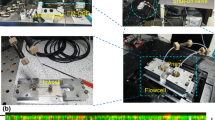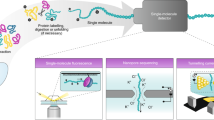Abstract
Cellular processes involve complex arrangement of proteins engaged in a multitude of reactions, yet in a highly coordinated manner. The level of complexity, however, makes it difficult to investigate the role played by the individual protein constituent. Data taken from the conventional bulk solution methods suffer from ensemble averaging effect in which information from individual molecules is masked. The single molecule detection method overcomes this limitation by offering unique tools for monitoring the activity of individual molecules in isolation and in real-time dynamics. Included in this review are recent articles of single molecule studies representing a diverse array of experimental platforms which demonstrate the power and spectrum of single molecule detection.







Similar content being viewed by others
References
Bandwar, R. P., G. Q. Tang, and S. S. Patel. Sequential release of promoter contacts during transcription initiation to elongation transition. J. Mol. Biol. 360(2):466–483, 2006.
Benkovic, S. J., A. M. Valentine, and F. Salinas. Replisome-mediated DNA replication. Annu. Rev. Biochem. 70:181–208, 2001.
Blinkova, A., et al. The Escherichia coli DNA polymerase III holoenzyme contains both products of the dnaX gene, tau and gamma, but only tau is essential. J. Bacteriol. 175(18):6018–6027, 1993.
Bochkareva, E., et al. Structure of the major single-stranded DNA-binding domain of replication protein A suggests a dynamic mechanism for DNA binding. EMBO J. 20(3):612–618, 2001.
Bochkareva, E., et al. Structure of the RPA trimerization core and its role in the multistep DNA-binding mechanism of RPA. EMBO J. 21(7):1855–1863, 2002.
Cai, L., et al. Structural characterization of human RPA sequential binding to single-stranded DNA using ssDNA as a molecular ruler. Biochemistry 46(28):8226–8233, 2007.
Chung, S. H., and R. A. Kennedy. Forward-backward non-linear filtering technique for extracting small biological signals from noise. J. Neurosci. Methods 40(1):71–86, 1991.
Cui, S., et al. The C-terminal regulatory domain is the RNA 5′-triphosphate sensor of RIG-I. Mol. Cell. 29(2):169–179, 2008.
De Vlaminck, I., et al. Torsional regulation of hRPA-induced unwinding of double-stranded DNA. Nucleic Acids Res. 2010.
Durniak, K. J., S. Bailey, and T. A. Steitz. The structure of a transcribing T7 RNA polymerase in transition from initiation to elongation. Science 322(5901):553–557, 2008.
Fanning, E., V. Klimovich, and A. R. Nager. A dynamic model for replication protein A (RPA) function in DNA processing pathways. Nucleic Acids Res. 34(15):4126–4137, 2006.
Gong, P., E. A. Esposito, and C. T. Martin. Initial bubble collapse plays a key role in the transition to elongation in T7 RNA polymeras. J. Biol. Chem. 279(43):44277–44285, 2004.
Guo, Q., et al. Major conformational changes during T7RNAP transcription initiation coincide with, and are required for, promoter release. J. Mol. Biol. 353(2):256–270, 2005.
Hamdan, S. M., et al. Dynamics of DNA replication loops reveal temporal control of lagging-strand synthesis. Nature 457(7227):336–339, 2009.
Hodges, C., et al. Nucleosomal fluctuations govern the transcription dynamics of RNA polymerase II. Science 325(5940):626–628, 2009.
Hornung, V., et al. 5′-Triphosphate RNA is the ligand for RIG-I. Science 314(5801):994–997, 2006.
Huang, B., et al. Whole-cell 3D STORM reveals interactions between cellular structures with nanometer-scale resolution. Nat. Methods 5(12):1047–1052, 2008.
Iftode, C., Y. Daniely, and J. A. Borowiec. Replication protein A (RPA): the eukaryotic SSB. Crit. Rev. Biochem. Mol. Biol. 34(3):141–180, 1999.
Jin, J., et al. Synergistic action of RNA polymerases in overcoming the nucleosomal barrier. Nat. Struct. Mol. Biol. 17(6):745–752, 2010.
Johnson, A., and M. O’Donnell. Cellular DNA replicases: components and dynamics at the replication fork. Annu. Rev. Biochem. 74:283–315, 2005.
Joo, C., et al. Real-time observation of RecA filament dynamics with single monomer resolution. Cell 126(3):515–527, 2006.
Kim, C., and M. S. Wold. Recombinant human replication protein A binds to polynucleotides with low cooperativity. Biochemistry 34(6):2058–2064, 1995.
Kim, S., C. M. Schroeder, and X. S. Xie. Single-molecule study of DNA polymerization activity of HIV-1 reverse transcriptase on DNA templates. J. Mol. Biol. 395(5):995–1006, 2010.
Kowalczykowski, S. C. Initiation of genetic recombination and recombination-dependent replication. Trends Biochem. Sci. 25(4):156–165, 2000.
Kowalczykowski, S. C., et al. Biochemistry of homologous recombination in Escherichia coli. Microbiol. Rev. 58(3):401–465, 1994.
Kuzminov, A. Recombinational repair of DNA damage in Escherichia coli and bacteriophage lambda. Microbiol. Mol. Biol. Rev. 63(4):751–813, 1999; (table of contents).
Lao, Y., C. G. Lee, and M. S. Wold. Replication protein A interactions with DNA. 2. Characterization of double-stranded DNA-binding/helix-destabilization activities and the role of the zinc-finger domain in DNA interactions. Biochemistry 38(13):3974–3984, 1999.
Leake, M. C., et al. The elasticity of single kettin molecules using a two-bead laser-tweezers assay. FEBS Lett. 535(1–3):55–60, 2003.
Leake, M. C., et al. The elasticity of single titin molecules using a two-bead optical tweezers assay. Biophys. J. 87(2):1112–1135, 2004.
Leake, M. C., et al. Stoichiometry and turnover in single, functioning membrane protein complexes. Nature 443(7109):355–358, 2006.
Lee, J. B. DNA primase acts as a molecular brake in DNA replication. Nature 439(7076):621–624, 2006.
Liu, C., and C. T. Martin. Promoter clearance by T7 RNA polymerase. Initial bubble collapse and transcript dissociation monitored by base analog fluorescence. J. Biol. Chem. 277(4):2725–2731, 2002.
Lohman, T. M., and M. E. Ferrari. Escherichia coli single-stranded DNA-binding protein: multiple DNA-binding modes and cooperativities. Annu. Rev. Biochem. 63:527–570, 1994.
Maier, B., D. Bensimon, and V. Croquette. Replication by a single DNA polymerase of a stretched single-stranded DNA. Proc. Nat. Acad. Sci. U.S.A. 97(22):12002–12007, 2000.
McInerney, P., and M. O’Donnell. Replisome fate upon encountering a leading strand block and clearance from DNA by recombination proteins. J. Biol. Chem. 282(35):25903–25916, 2007.
Mer, G., et al. Structural basis for the recognition of DNA repair proteins UNG2, XPA, and RAD52 by replication factor RPA. Cell 103(3):449–456, 2000.
Myong, S., et al. Cytosolic viral sensor RIG-I is a 5′-triphosphate-dependent translocase on double-stranded RNA. Science 323(5917):1070–1074, 2009.
Negroni, M., and H. Buc. Mechanisms of retroviral recombination. Annu. Rev. Genet. 35:275–302, 2001.
O’Donnell, M. Replisome architecture and dynamics in Escherichia coli. J. Biol. Chem. 281(16):10653–10656, 2006.
Pandey, M., et al. Coordinating DNA replication by means of priming loop and differential synthesis rate. Nature 462(7275):940–943, 2009.
Pichlmair, A., et al. RIG-I-mediated antiviral responses to single-stranded RNA bearing 5′-phosphates. Science 314(5801):997–1001, 2006.
Plank, M., G. H. Wadhams, and M. C. Leake. Millisecond timescale slimfield imaging and automated quantification of single fluorescent protein molecules for use in probing complex biological processes. Integr. Biol. (Camb) 1(10):602–612, 2009.
Reyes-Lamothe, R., D. J. Sherratt, and M. C. Leake. Stoichiometry and architecture of active DNA replication machinery in Escherichia coli. Science 328(5977):498–501, 2010.
Roca, A. I., and M. M. Cox. RecA protein: structure, function, and role in recombinational DNA repair. Prog. Nucleic Acid Res. Mol. Biol. 56:129–223, 1997.
Roda, R. H., et al. Role of the reverse transcriptase, nucleocapsid protein, and template structure in the two-step transfer mechanism in retroviral recombination. J. Biol. Chem. 278(34):31536–31546, 2003.
Roy, R., et al. SSB protein diffusion on single-stranded DNA stimulates RecA filament formation. Nature 461(7267):1092–1097, 2009.
Sanborn, M. E., et al. Fluorescence properties and photophysics of the sulfoindocyanine Cy3 linked covalently to DNA. J. Phys. Chem. B 111(37):11064–11074, 2007.
Shereda, R. D., et al. SSB as an organizer/mobilizer of genome maintenance complexes. Crit. Rev. Biochem. Mol. Biol. 43(5):289–318, 2008.
Shroff, H., H. White, and E. Betzig. Photoactivated localization microscopy (PALM) of adhesion complexes. Curr. Protoc. Cell Biol., 2008. Chapter 4: p. Unit 4 21.
Shundrovsky, A. A single-molecule technique to study sequence-dependent transcription pausing. Biophys. J. 87(6):3945–3953, 2004.
Smith, D. A. A quantitative method for the detection of edges in noisy time-series. Philos. Trans. R. Soc. B-Biol. Sci. 353(1378):1969–1981, 1998.
Stano, N. M., et al. DNA synthesis provides the driving force to accelerate DNA unwinding by a helicase. Nature 435(7040):370–373, 2005.
Tang, G. Q., and S. S. Patel. T7 RNA polymerase-induced bending of promoter DNA is coupled to DNA opening. Biochemistry 45(15):4936–4946, 2006.
Tang, G. Q., et al. Real-time observation of the transition from transcription initiation to elongation of the RNA polymerase. Proc. Nat. Acad. Sci. U.S.A. 106(52):22175–22180, 2009.
Treuner, K., U. Ramsperger, and R. Knippers. Replication protein A induces the unwinding of long double-stranded DNA regions. J. Mol. Biol. 259(1):104–112, 1996.
Wold, M. S. Replication protein A: a heterotrimeric, single-stranded DNA-binding protein required for eukaryotic DNA metabolism. Annu. Rev. Biochem. 66:61–92, 1997.
Wuite, G. J., et al. Single-molecule studies of the effect of template tension on T7 DNA polymerase activity. Nature 404(6773):103–106, 2000.
Yin, Y. W., and T. A. Steitz. Structural basis for the transitionfrom initiation to elongation transcription in T7 RNA polymerase. Science 298(5597):1387–1395, 2002.
Yoneyama, M., et al. The RNA helicase RIG-I has an essential function in double-stranded RNA-induced innate antiviral responses. Nat. Immunol. 5(7):730–737, 2004.
Zou, Y., et al. Functions of human replication protein A (RPA): from DNA replication to DNA damage and stress responses. J. Cell. Physiol. 208(2):267–273, 2006.
Author information
Authors and Affiliations
Corresponding author
Additional information
Associate Editor Yingxiao Wang oversaw the review of this article.
Rights and permissions
About this article
Cite this article
Qiu, Y., Myong, S. Single Molecule Detection of One, Two and Multiplex Proteins Involved in DNA/RNA Transaction. Cel. Mol. Bioeng. 4, 125–137 (2011). https://doi.org/10.1007/s12195-011-0159-x
Received:
Accepted:
Published:
Issue Date:
DOI: https://doi.org/10.1007/s12195-011-0159-x




